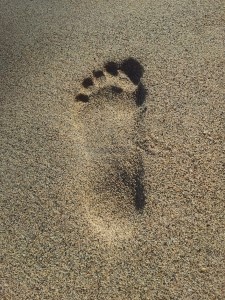Creating sustainable futures/CSF102/Identifying trends/Ecological footprint
From WikiEducator
Emerging measurements of human impacts on the planet are gaining mainstream credibility. The Ecological Footprint has been developed by an international coalition called the Global Footprint Network as a measure of our use of the planet’s biocapacity. The Ecological Handprint measure seeks to build upon the Footprint measure and reframe the concept of sustainability by looking not just at ecological impacts but also ensuring sustenance for those in need.
Ecological Footprint
The ‘ecological footprint’ of humanity is gaining attention as way of measuring the amount of resources we consume and the waste we produce against the planet’s ability to produce those resources and ‘digest’ our waste. Currently, every year we are exceeding the planet’s ‘biocapacity’ to perform these functions by about 50%. The ecological footprint calls this an ‘overshoot’. In 2014, overshoot day - that is the day we used up 100% of the planet’s biocapacity - fell on August 19th. But in 2016 we will have reached overshoot day even earlier, on August 8. We use more ecological resources and services than nature can regenerate through overfishing, overharvesting forests and emitting more carbon dioxide into the atmosphere than forests can sequester.
Ecological Handprint
Ecological Handprints bring a social dimension to the issue of measuring our Footprint and recognise the need for people’s needs to be met as part of the sustainability agenda. This concept suggests that we can achieve a high level of human development without compromising the ecological systems upon which all life depends.



